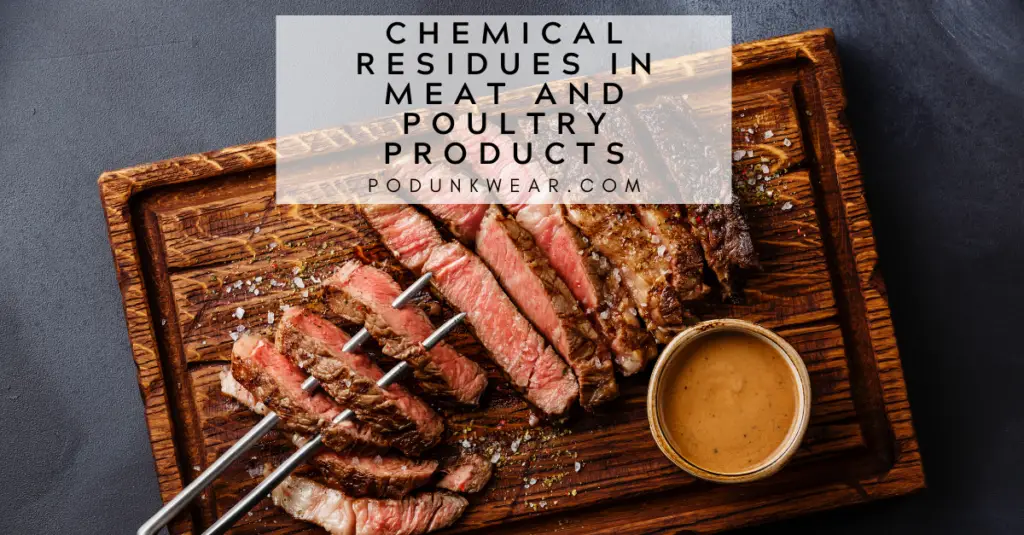Meat has been inspected since Roosevelt passed the Federal Meat Inspection Act of 1906. This act was passed due to a report of poor meat packing conditions reported in Chicago in 1905. As industrialized farming has increased, federal government agencies have created departments to inspect the quality of our foods, and develop an enforcement action plan for those that do not follow the regulatory agencies guidelines. The U.S. National Residue Program (NRP) operates under the USDA Food Safety and Inspection Service, which samples meat products from various animals and creates annual reports of the residues found. This service is intended as a public health service, inspecting food to ensure that it is complying with maximum residue limits. The USDA works closely with veterinary medicine, to develop practices that ensure the safety of animal health and human health, in the transition from farm to table.
Antibiotics:
Antibiotic residues are measured due to the concern of misuse, which can lead to antibiotic-resistant bacteria. Antibiotic resistant bacteria is the scariest form of bacteria for physicians and medical personnel. This is one of the most difficult pathogens to treat, and treatment usually requires extremely strong antibiotics, which are very hard on the body. The Department of Health has programs that are intended to educate the public about the proper use of antibiotics, to limit the growth and spread of resistance.
Aminoglycosides:
Aminoglycoside is a type of antibiotic effective against Escherichia coli. Aminoglycosides are often given to patients preoperatively, who are at risk for nosocomial or postoperative infections. Aminoglycosides are nephrotoxic, meaning they can damage the kidneys. One study has shown that after only a few days of administration of clinical doses to humans and animals (typically 10 to 20 mg/kg of body weight for a laboratory rat), aminoglycosides induce characteristic changes in the kidneys. In humans, these signs and symptoms were followed by the development of renal failure. This is monitored by a decrease in creatinine clearance, usually measured by blood draws. Creatinine is a waste product in blood that is removed from the blood by the kidneys. Blood draws that measure creatinine clearance from the kidneys is an easy and cost-effective way to measure how well the kidneys are functioning.
2020 Samples testing positive for Aminoglycosides: 850/850 beef samples, 419/420 veal, 863/863 dairy cows, 867/869 market swine, 0/57 feral swine (wild hogs), 0/312 roaster swine, 714/715 sows, 396/397 young chickens, 219/219 whole chickens, 654/656 young turkeys, 298/298 goats, 127/127 lambs, 105/105 sheep, and 0/161 egg products.
Carbadox:
Carbadox is an in-feed antibiotic that is widely used in swine production, to prevent dysentery and to improve feed efficiency. Appropriately high doses of antibiotics are administered to treat or prevent disease (therapeutic use), and relatively low doses are typically used to improve feed efficiency (non-therapeutic use). Many countries are banning or regulating non-therapeutic veterinary antibiotics, because low-dose antibiotics can result in the use of antibiotics that do not kill or inhibit bacterial growth. These subinhibitory antibiotic concentrations are undesired because they can cause antibiotic resistance genes. One study showed that bacteroidetes (a common gut bacteria) populations increased by 17% in carbadox medicated animals, while firmicutes (gut bacteria that supports immune function and digestion) population decreased by 17%. Another study found that pigs fed carbadox had increased susceptibility to E. Coli infections, which also lead to small intestinal bacteria overgrowth (SIBO). SIBO can occur in pigs and humans without symptoms. One study on humans found that out of 52 people without a known history of SIBO, found 50% have SIBO. In another uncontrolled study, researchers found that 78% of 202 patients with irritable bowel syndrome (IBS) had SIBO. In a similar study, out of 15 celiac patients with persistent celiac symptoms, despite adherence to a strict gluten-free diet, found that 66% had SIBO.
2020 Samples testing positive for Carbadox: 0/850 beef samples, 0/420 veal, 0/863 dairy cows, 0/869 market swine, 0/57 feral swine (wild hogs), 311/312 roaster swine, 0/715 sows, 0/397 young chickens, 0/219 whole chickens, 0/656 young turkeys, 0/298 goats, 0/127 lambs, 0/105 sheep, and 0/161 egg products.
Nitrofurans:
Nitrofuran is an antibiotic that is prescribed to humans for the treatment of urinary tract infections (UTIs). Since 1991, nitrofurans have been banned for systemic use in poultry and swine, because the drugs have been shown to cause cancer. Topical uses however, have been allowed because there is no evidence that the drugs reach edible tissues. Obviously, the residue levels found in meat are illegal residues, and should not be consumed due to the health risk associated.
2020 Samples testing positive for Nitrofurans: 0/850 beef samples, 0/420 veal, 0/863 dairy cows, 0/869 market swine, 0/57 feral swine (wild hogs), 311/312 roaster swine, 0/715 sows, 169/397 young chickens, 213/219 whole chickens, 315/656 young turkeys, 0/298 goats, 0/127 lambs, 0/105 sheep, 218/564 fish, and 0/161 egg products.
Beta-Agonists
Currently, there are two βeta-agonists that have received approval from the U.S. Food and Drug Administration (FDA) for use as livestock feed additives. They are ractopamine hydrochloride, operating under trade names Paylean® which can be given to swine since 1999, Optaflexx® which can be given to cattle since 2003, and Topmax® which can be given to turkeys since 2008. The other is zilpaterol hydrochloride, operating under the trade name Zilmax® which can be given to cattle since 2006. These drugs are also approved for use in Brazil, Canada, South Korea, and Mexico. Beta-agonists are a class of non-hormonal compounds fed to cattle. They are given to animals to reduce the metabolism of fat, producing leaner cuts of meat. Beta-agonists used in livestock production are mixed into animal feeds at precise levels and are consumed by animals during the last few weeks of life prior to slaughter. The additives are absorbed into the bloodstream from the digestive tract, causing a chain of events within the animals’ cells which alter their metabolism, growth, and development of muscle and fat tissue within the animal. Although the potencies of ractopamine and zilpaterol are much lower than clenbuterol (which has been banned in the United States since 1991), adverse health effects including mortality have been traced to these β-agonists in cattle and swine. A 3-day withdrawal period is required zilpaterol prior to slaughter, but no withdrawal times are required for ractopamine. Detectable residues of ractopamine remain quantifiable in pig muscle 5 to 7 days after an animal is slaughtered, and in some edible organs (liver) for a longer period of time.
For ractopamine, the US FDA allows up to 30 ppb of ractopamine residue in raw muscles of cattle, 50 ppb ractopamine residue in hogs, and 100 ppb ractopamine residue in turkeys. The U.S. FDA allows up to 90 ppb for raw livers in cattle, 150 ppb in hog livers, and 450 ppb in turkey livers. For zilpaterol, the FDA allows 12 ppb of in uncooked liver of cattle. In humans, the Acceptable Daily Intake (ADI) values set by the US FDA are 1.25 mcg/kg of body weight per day for ractopamine, and 0.083 mcg/kg of body weight per day for zilpaterol. (ADIs set by the United Nations and WHO are 0–1 mcg/kg of body weight for ractopamine and 0–0.04 mcg/kg of body weight/day for zilpaterol). FYI: 1 part per billion (ppb) = 1 mcgg/kg (microgram per kilogram).
- Americans eat an average of 10 ounces (0.28 kg) of meat per day:
- 0.28 kg of meat x 450 ppb (high limit) = 126 mcg total ractopamine /80kg (176 lb person) = 1.575 mcg of ractopine/kg/day)
- Limit set by the World Health Organization is 1 mcg/kg/day
It is important to note that ractopamine has a half-life of approximately 4 hours in blood. In humans orally dosed with 40 mg of ractopamine, approximately 33% of the total dose was excreted in urine within 6 hours, and 45.7% of the total dose was excreted in urine by 24 hours. This means that Americans can ingest ractopamine faster than they can eliminate it.
The acceptable daily intake limit for ractopamine and zilpaterol is set to avoid adverse cardiac effects in humans. Unfortunately, one study has established that cooking food containing ractopamine does not completely degrade the toxic chemical. Studies also show that steers fed zilpaterol or ractopamine had greater average heart rates than those fed the control diet not containing these agents. There is also concern that administration of ractopamine or zilpaterol might be associated with an increased incidence of feedlot cattle deaths, which is a relatively rare event in feedlot cattle (before slaughter). Zilpaterol and ractopamine administration is also associated with increased serum creatine phosphokinase (CPK), even when they are administered in accordance with the FDA-approved label directions. This indicates that kidney function declines with consumption. Evidence also shows an increase of illness in beef cattle, which is demonstrated by an increase in meat classified as dark, firm, and dry when examine for quality control by state agencies. In addition to cardiotoxicity and nephorotoxicity, animal studies suggest that ractopamine and zilpaterol can also lead to tumor growth. Experimental data has shown that ractopamine and zilpaterol are not mutagenic or genotoxic, however, regular exposure in mice increases the incidence of uterine leiomyoma (or fibroids), which in humans can cause heavy menstrual bleeding, pelvic pain, or irregular menstrual cycles. Another study has shown that ractopamine can act as an endocrine disruptor, and can activate estrogen receptors. The activation of estrogen receptors can possibly lead to breast cancer. Further research is needed on the potency of ractopamine needed to activate the estrogen receptors (ER).
In human trials, there is evidence of adverse drug events in long-acting β2 adrenergic agonists (beta-agonists) used for the treatment of diseases like asthma. The FDA now requires a boxed warning of adverse effects to be included on the labels of all long-acting beta 2 adrenergic agonists, intended to be administered daily for the control of asthma. In addition to the increased risk of death from asthma attacks with the use of daily inhalers, other studies have reported an increased risk of myocardial disease in patients using βAA drugs. These include short-acting rescue inhalers like albuterol or levalbuterol, and long-acting medications like salmeterol, formoterol, arformoterol, olodaterol, and indacaterol.
Clenbuterol (banned in the U.S. since 1991), is also a βeta-agonist but is more concentrated than zilpaterol or ractopamine. The higher concentrations given to food animals have led to adverse effects in humans. These adverse effects include elevated heart rate, high blood pressure, anxiety, palpitation, and skeletal muscle tremors. Thus, clenbuterol has been banned worldwide for any growth uses in food animals. Acute adverse effects associated with β-agonists in general, are well known and are predictable. Human adverse effects from clenbuterol have been noted in the instances of food poisoning, caused by violative residues in illicitly-treated animals.
2020 Samples testing positive for Beta-Agonists: 430/850 beef samples, 208/420 veal, 436/863 dairy cows, 464/869 market swine, 0/57 feral swine (wild hogs), 0/312 roaster swine, 350/715 sows, 0/397 young chickens, 0/219 whole chickens, 0/656 young turkeys, 0/298 goats, 0/127 lambs, 47/105 sheep, and 103/161 egg products.
Metals
Heavy metals such as arsenic, cadmium, chromium, coppe, mercury, lead, nickel (Ni), and zinc occur naturally in the soil. Other sources of heavy metals include mining, industrial waste, urban runoff, sewage discharge, and insect control in agricultural chemicals. Although some heavy metals (cobalt, copper, chromium, nickel, and zinc) play key biological functions in the organisms, they can be toxic at high concentrations. Non-essential heavy metals (cadmium, lead, and mercury) are toxic even at very low concentrations.
2020 Samples testing positive for metals: 118/850 beef samples, 99/420 veal, 120/863 dairy cows, 127/869 market swine, 0/57 feral swine (wild hogs), 0/312 roaster swine, 106/715 sows, 90/397 young chickens, 0/219 whole chickens, 132/656 young turkeys, 0/298 goats, 0/127 lambs, 0/105 sheep, 283/564 fish, and 0/161 egg products.
Pesticides
Avermectins
Avermectin has been widely used as an agricultural pesticide, against both internal and external parasites of livestock. The Environmental Protection Agency has determined that avermectin is relatively safe for humans and other vertebrates. Avermectin is also used in various crop and food production including tree fruits, nuts, rice, and cotton.
Avermectin generally works by preventing the transmission of electrical impulses in the muscles and nerves of invertebrates. This causes paralysis of the invertebrate neuromuscular systems. The administered doses that lead to this damage are not toxic to mammals, because that they do not have the invertebrate’s glutamate-gated chloride channel which avermectin uses. Studies have shown that avermectins can induce oxidative, cause immunological damage, as can cause genotoxicity in mammals, birds, and fish.
Ivermectin is the most common avermectin derivative. It is used by humans to treat gastrointestinal strongyloidiasis (a disease caused by roundworm) in the United States. In animals (like pet dogs), it is used to prevent heartworm, treat ectoparasites, and as a microfilaricide (meaning to kill parasites in their early stages of life).
It is reported that some patients with filarial infection (a disease caused by parasitic worms), developed transient (short term) to mild side effects when administered Ivermectin. The side effects reported include anorexia, headache, myalgia, arthralgia, fever, eosinophilia (elevated white blood cells), and asthenia (weakness or lethargy). Patients with filarial infections taking avermectins (like Ivermectin) have reported Mazzotti reactions including fever, urticaria, tachycardia, hypotension, edema, abdominal pain, and sudden death. Also, 33% of scabies patients administered Ivermectin developed popular rashes and pruritus (itching) 2 to 4 days later. Other symptoms observed in some of the patients administered Ivermectin include hematomas, prolonged blood prothrombin time (which can cause excessive bleeding risks), nausea, decrease in blood pressure, and EKG (heart rhythm) changes, and immune system alterations causing immunosuppression (the inability to fight infections).
Ivermectin has been shown to cause adverse effects in various mouse strains and dog breeds, even at the correct therapeutic dosage. One study demonstrates that exposure to ivermectin to neonatal mice reduced the animals’ adult weight, even after drug exposure had ceased. There was also an increased mortality rate in neonatal mice in the higher dose groups, which is most likely due to their mother’s milk having an elevated level of ivermectin. This is because the Ivermectin is lipophilic, meaning it is excreted from the mom through milk in concentrated levels. The larger problem is that the blood–brain barrier of rodents is not fully developed until approximately 10 days of age. The blood brain barrier is what prevents toxins and pathogens (bacteria, viruses, fungi, etc) from entering the brain, and causing brain infections. With an immature blood-brain barrier, the drug and other toxins can enter the brain and spinal cord and cause brain damage. One study demonstrates that rats exposed to ivermectin accumulated ivermectin to toxic levels in the brain, and caused neonatal mortality.
The maximum residue limit for dairy cattle for milk production set by the WHO is 0.01 mg/kg while the acceptable daily intake is 0-0.001 mg/kg bw.
In 2013 the MRI for Ivermectin in cattle muscle was 4 mcg/kg, however in 2015 the MRI was increased to 400 μg/kg for fat, 100 μg/kg for kidney, 800 μg/kg for liver and 30 μg/kg for muscle in cattle.
In 2013 the ADI for Ivermectin was 0-1 mcg/kg of bw, however the ADI limit of Ivermectin was increased in 2015 to 0-10 mcg/kg of bw.
The increased use of pesticides combined with the inappropriate use of veterinary drugs, like ivermectin usage related to COVID-19, has public health officials worried about the potential risk to public health.
2020 Samples testing positive for Avermectins: 91/850 beef samples, 48/420 veal, 100/863 dairy cows, 94/869 market swine, 0/57 feral swine (wild hogs), 0/312 roaster swine, 85/715 sows, 0/397 young chickens, 0/219 whole chickens, 0/656 young turkeys, 40/298 goats, 24/127 lambs, 12/105 sheep, and 0/161 egg products.
Other Pesticides
Pesticide residues found in meat is due to the application to the food products that make up the animal feed. There are also environmental contaminants that can elevate the amount of pesticides the livestock is ingesting.
2020 Samples testing positive for other pesticides: 433/850 beef samples, 212/420 veal, 441/863 dairy cows, 465/869 market swine, 57/57 feral swine (wild hogs), 0/312 roaster swine, 351/715 sows, 191/397 young chickens, 219/219 whole chickens, 320/656 young turkeys, 145/298 goats, 20/127 lambs, 57/105 sheep, 263/564 fish, and 161/161 egg products.
How to Avoid Toxins in Meats:
- The best way to have control of the quality of your meat, is to grow and slaughter your own meat. Starting with eggs is one way to ease into animal husbandry. Chickens are the ultimate “green” livestock, as they can turn your chicken scraps into breakfast. Make sure to give chickens healthy animal feed to ensure the quality of the eggs. Some people even grow their own livestock feed. Check out 23 Pesticide Covered Foods You Can Easily Grow at Home for cheap organic chicken feed options.
- Choose organic meats: organic food does not mean that it is free of chemicals, but it does have less chemicals. Studies have shown that families have less toxins in their urine and reported a lower prevalence of allergies with a lifestyle of organic food.
Sources:
- https://www.fsis.usda.gov/sites/default/files/media_file/2020-07/2018-red-book.pdf
- https://www.fsis.usda.gov/sites/default/files/media_file/2021-05/FY_2020_Sampling_Summary_Report.pdf
- https://www.ncbi.nlm.nih.gov/pmc/articles/PMC6876965/
- https://www.ncbi.nlm.nih.gov/pmc/articles/PMC7464486/
- https://www.ncbi.nlm.nih.gov/pmc/articles/PMC3951294/
- https://www.ncbi.nlm.nih.gov/pmc/articles/PMC5587842/
- https://www.ncbi.nlm.nih.gov/pmc/articles/PMC7460413/
- https://pubmed.ncbi.nlm.nih.gov/21524425/
- https://apps.who.int/food-additives-contaminants-jecfa-database/chemical.aspx?chemID=112
- https://www.ncbi.nlm.nih.gov/pmc/articles/PMC5658984/





